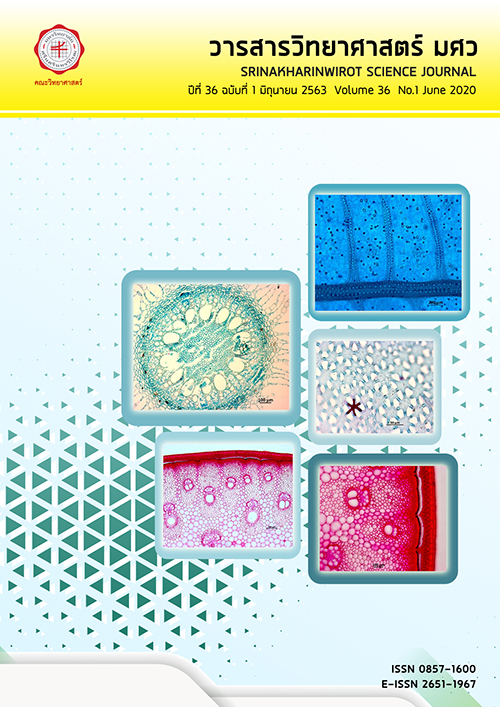The Study of Exchange Bias Phenomenon in Read Head via the Realistic Micromagnetic Model
Keywords:
Exchange bias phenomenon, Landau-Lifshitz-Gilbert equation, Kinetic Monte Carlo method, ปรากฏการณ์ไบอัสแลกเปลี่ยน, สมการแลนดอว์-ลิฟชิทซ์-กิลเบิร์ต, วิธีมอนติคาร์โลเชิงจลน์Abstract
บทคัดย่อ ในงานวิจัยนี้ได้นำเสนอแบบจำลองทางแม่เหล็กเสมือนจริงระดับจุลภาคซึ่งถูกประยุกต์ใช้ในการศึกษาปรากฏการณ์ไบอัสแลกเปลี่ยนในโครงสร้างวัสดุแม่เหล็กสองชั้นประกอบด้วยวัสดุแม่เหล็กโคบอลต์ไอรอนที่เชื่อมต่อกับวัสดุแม่เหล็กอิริเดียมแมงกานีสซึ่งเป็นวัสดุแม่เหล็กที่ถูกนำไปใช้ในหัวอ่านข้อมูลฮาร์ดดิสก์ไดร์ฟ วัสดุแม่เหล็กโคบอลต์ไอรอนและวัสดุแม่เหล็กอิริเดียมแมงกานีสเป็นวัสดุแม่เหล็กเฟอร์โรแมกเนติกและแอนติเฟอร์โรแมกเนติกตามลำดับที่มีคุณสมบัติทางแม่เหล็กที่แตกต่างกัน งานวิจัยนี้ได้นำเสนอรูปแบบจำลองทางแม่เหล็กเสมือนจริงระดับจุลภาคซึ่งสามารถอธิบายพฤติกรรมทางแม่เหล็กของวัสดุทั้งสองได้อย่างถูกต้อง ในการศึกษาปรากฏการณ์ไบอัสแลกเปลี่ยน สำหรับวัสดุแม่เหล็กเฟอร์โรแมกเนติกพลวัตของแมกนิไทเซชันสามารถถูกอธิบายได้ด้วยสมการแลนดอว์-ลิฟชิทซ์-กิลเบิร์ต ในขณะที่วัสดุแม่เหล็กแอนติเฟอร์โรแมกเนติกจะเลือกใช้วิธีมอนติคาร์โลเชิงจลน์ในการอธิบาย นอกจากนี้แบบจำลองที่ถูกนำเสนอขึ้นมานี้ยังได้รับการพัฒนาให้สามารถควบคุมพารามิเตอร์ของระบบได้อย่างมีความเสมือนจริง ได้แก่ ขนาดของโครงสร้างของระบบ ขนาดเส้นผ่านศูนย์กลางของเกรนแม่เหล็ก การกระจายตัวขนาดของเกรนแม่เหล็กและผลของการตัดเกรนแม่เหล็กที่บริเวณขอบของฟิล์มแม่เหล็ก แบบจำลองทางแม่เหล็กเสมือนจริงระดับจุลภาคถูกนำไปใช้ในการคำนวณค่าสนามไบอัสแลกเปลี่ยนเนื่องจากการเปลี่ยนแปลงของค่าสนามแลกเปลี่ยนระหว่างชั้นวัสดุและขนาดเส้นผ่านศูนย์กลางของเกรนแม่เหล็ก ผลการคำนวณให้ค่าที่สอดคล้องกับทฤษฎีและผลการทดลองเป็นอย่างดี นอกจากนี้ยังได้ทำการพิจารณาผลของลักษณะของโครงสร้างที่มีการตัดเกรนแม่เหล็กที่บริเวณขอบฟิล์มในโครงสร้างที่มีขนาดเล็กลงพบว่าค่าสนามไบอัสแลกเปลี่ยนของโครงสร้างที่มีการพิจารณาผลของการตัดเกรนแม่เหล็กจะมีค่าต่ำกว่าค่าสนามไบอัสแลกเปลี่ยนของโครงสร้างที่ไม่มีการพิจารณาผลของการตัดเกรนแม่เหล็กที่ขอบฟิล์มถึง 20 เปอร์เซ็นต์เนื่องจากปริมาตรของเกรนแม่เหล็กที่บริเวณขอบถูกตัดออกไปจากโครงสร้างขนาดเล็กนั้นมีปริมาณที่สูงมากเมื่อเปรียบเทียบกับปริมาตรของเกรนแม่เหล็กภายในระบบ ABSTRACT In this work we propose the realistic micromagnetic model used to study the exchange bias phenomenon in magnetic bilayer system such as CoFe coupled with IrMn for read head sensor in hard disk drive. CoFe and IrMn are ferromagnetic and antiferromagnetic materials respectively which have the different magnetic properties. We propose the realistic micromagnetic model which can describe the magnetic behavior for both materials for the study of exchange bias phenomena. For ferromagnetic material, the dynamics of the magnetization is explained by Landau-Lifshitz-Gilbert (LLG) equation meanwhile the kinetic Monte Carlo method is used for antiferromagnetic material. Moreover, this model has been modified to control the parameters of the system such as system size, grain diameter, grain size distribution and grain cutting at the edges of the structures. The micromagnetic model is used to investigate the exchange bias field ( ) due to the effects of exchange interlayer field ( ) and grain diameter. The results give good agreement with the theoretical and experiment works. In addition, the effect of grain cutting in small scale system is considered. We found that the for system including etching effect reduces 20 percent of no etch effect structure because the volume of the cutting area is comparable with the total area.Downloads
Download data is not yet available.
Downloads
Published
2020-06-26
How to Cite
Chureemart, J., Sungkapila, W., & Chureemart, P. (2020). The Study of Exchange Bias Phenomenon in Read Head via the Realistic Micromagnetic Model. Science Essence Journal, 36(1), 159–176. Retrieved from https://ejournals.swu.ac.th/index.php/sej/article/view/11303
Issue
Section
Research Article








